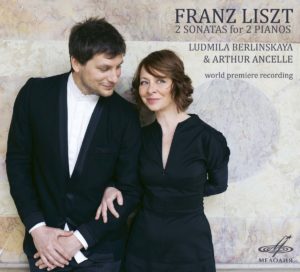Arranging Liszt’s iconic and influential Piano Sonata in B minor for two pianos seems like a ridiculous idea, except for the fact that Liszt himself actually wanted to do so but never got around to the task. It was left to Liszt’s friend Camille Saint-Saëns to realize this ambition in 1914. Now that I’ve heard the transcription’s first-ever recording, I’m pleased to report that Saint-Saëns did an impressive job.
His ingenious redistributions of lines, subtle textural reinforcements, and keen ear for sonority lend a convincing quasi-orchestral stature to the music, imbuing contrapuntal sequences and inner voices with enhanced profile and heft. The music’s soloistic nature makes it challenging for two pianists to synchronize rubato, agogics, timing, pedaling, and articulation, yet the husband/wife duo of Ludmila Berlinskaya and Arthur Ancelle have no ensemble problems whatsoever. Ancelle’s own two-piano adaptation of Liszt’s Dante Sonata also fleshes out Liszt’s original text in orchestrally conceived terms.
Two transcriptions of Saint-Saëns’ Danse macabre bookend the program: the first is the composer’s conservative but straightforwardly effective two-piano version, while the final selection is Ancelle’s concoction based on Liszt’s flashy emendations filtered through Vladimir Horowitz’s even flashier revisions. In other words, it’s a transcription of a transcription of a transcription! Again, the pianists’ ensemble values are beyond reproach, abetted by two unusually robust instruments that only sound overly clangorous when the music is at its loudest. Liszt aficionados and collectors of piano curiosities alike will need no further prodding to acquire this disc.
































